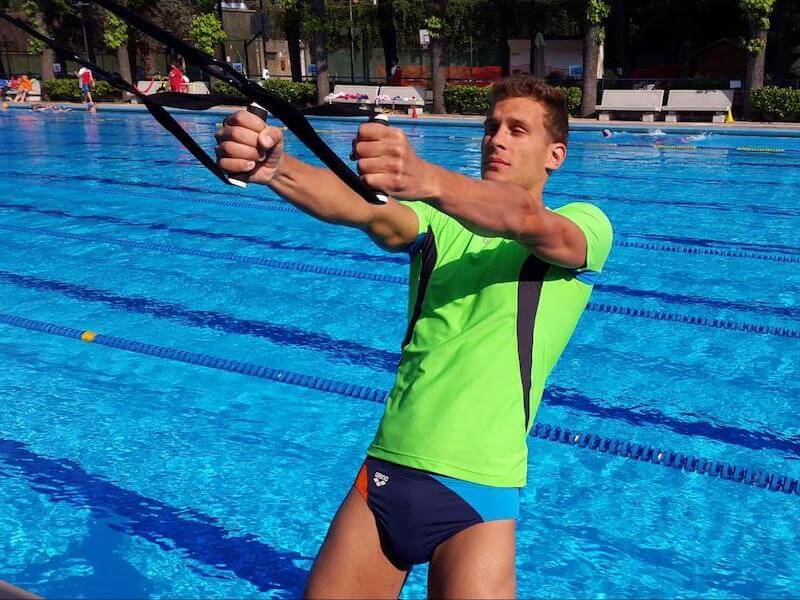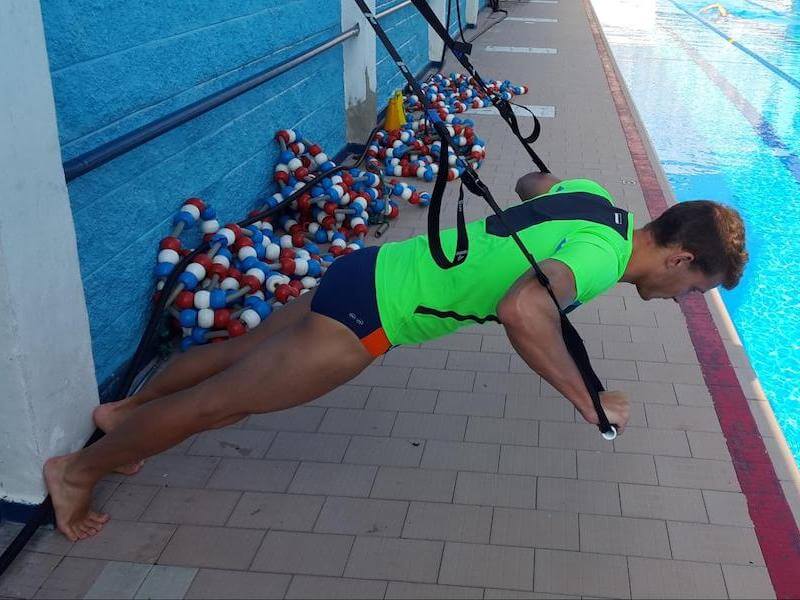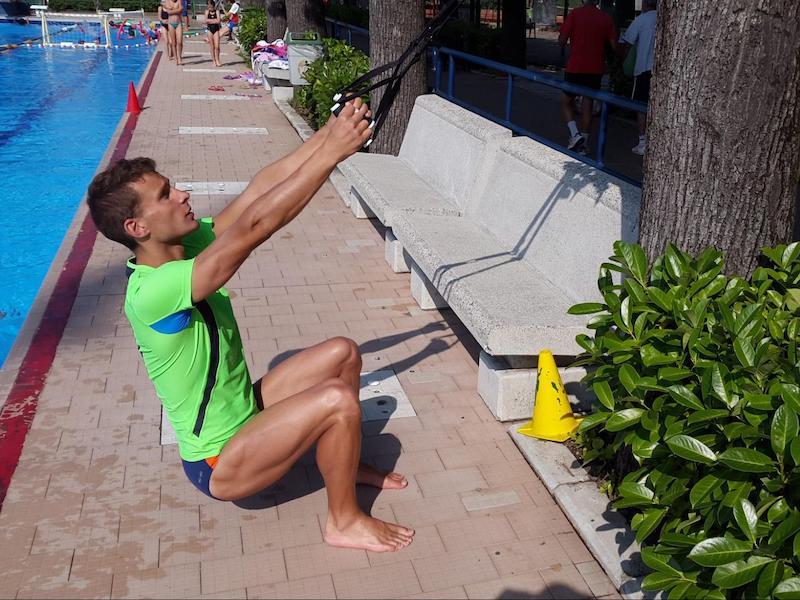Improve Performance With This TRX Navy SEAL Swim Workout
The infamous U.S. Navy SEALs training has become well-known in recent years, thanks to the rise of fitness gurus and motivational speakers like ex-Navy SEAL David Goggins. As someone who’s competed in many long-distance events and completes brutally long strength-training sessions every single day, he stresses the importance of regular training using your own bodyweight with high-rep calisthenics workout programs.
Navy SEALs take part in ocean swims during their training programs and even scuba dive. The clue is in their military title; simply put, Navy SEALs train to be operationally ready in and out of the water. Swimmers can gain insight from Navy SEAL swim workouts and apply the concepts to their own training.
In this article we’ll discuss TRX workout equipment, a simple yet effective tool invented by a former Navy SEAL. Then we’ll take a look at an example workout and explain an isolation exercise that’ll make your freestyle pull even stronger.
What Is TRX?

Cross training means using a different sport in your training to complement your own, and can be beneficial in any sport. Using on-land calisthenics to improve your swim training will give you better results in the pool. Getting out of your comfort zone not only teaches you new skills but it can also vastly improve your performance in the water.
One example is TRX, which stands for Total Body Resistance Exercise: total-body exercises using your own bodyweight for suspension training. It happens on land but the strength gains will help with your swimming performance.
The Navy SEAL training programs at the BUD/S training course are brutal both physically and mentally, designed to create soldiers ready for special warfare. Navy SEALs are always finding new ways to push themselves and each other, even when their access to equipment is limited. But not every Navy SEAL swim workout is filled with endless sit-ups, crunches, and flutter kicks.
Where does TRX equipment come from? It was designed by former Navy SEAL Randy Hetrick, who started to use the ropes of his own parachute because he had no other way of training, and ended up inventing the very first TRX.
Nowadays, a TRX isn’t made of parachute ropes but rather two handles into which you slide your hands or feet, connected to nylon straps that can be safely attached to practically anywhere — for example, a door in your home, a tree in the park, or wall bars at the gym. It’s the type of training plan where there really is no excuse to skip a workout. It’s also an easy-to-master, beginner-friendly piece of equipment.
You can easily add power to your swim stroke using a TRX, strengthening all the muscles used in the water. Train your chest, back, shoulders, and legs through plenty of conventional exercises (push-ups, pull-ups, squats, lunges, etc.) using a TRX, thanks to its versatility.
But that’s not all — your body will always be in an unbalanced position during any type of exercise, which means you’ll use and, therefore automatically train, the “stabilizer” muscles that help you keep your balance. In other words, all those abdominal and lumbar muscles (the core of your body) that are so important for keeping your body in the right position while swimming.
As we’ve already mentioned, TRX can be used anywhere and is an extremely versatile piece of equipment. But maybe the best thing of all about a TRX is that it’s not one of those exclusive objects only available to top-class athletes. In fact, like almost anything in calisthenics it’s modestly priced. That’s what makes working out with body weight so enjoyable. Unlike weight training, your body is the main tool of the workout and the equipment tends to be simple and inexpensive.
You can also decide how difficult to make each individual exercise; the greater the angle at which you perform the exercise, the more tiring it’ll be.
TRX Navy SEAL Swim Workout

Let’s put all this talk into practice. Try this easy-to-learn Navy SEAL swim workout for epic upper body gains.
Try 4-5 sets of at least 15 and at most 20 push-ups, at an angle of approximately 45 degrees to where the straps are attached, with a 1-minute recovery between sets. If at the end of the first set you feel as if you could’ve completed 5-10 more, then try to perform the second set at an angle of 55-60 degrees. If, on the other hand, you’re exhausted at the end of the first set, then reduce the angle to approximately 30 degrees for the second set.
Bearing in mind that you’ll be fresher at the start of your training schedule, you can begin with a slightly more demanding angle and then gradually reduce it according to your perceived exertion. Make sure you keep your body in the right position without arching your back or bending it inwards. Your ultimate goal might be to do push-ups with your arms almost parallel to the floor.
If you’re already well-acquainted with push-ups, you could superset this workout with traditional push-ups on the ground. Either way, all the different angles will leave you with shoulders on fire. The gains you’ll get on your chest and arms will serve you well in both breaststroke and freestyle.
That’s why we call this a “Navy SEAL swim workout” — it may be performed on land but the results will serve you well in the water.
TRX Isolation Exercise
Another special feature of a TRX is that it can be used for functional training or, in other words, exercises involving specific movements for a certain sport or activity. One highly specific exercise for swimming is called the freestyle pull, which, as the name itself suggests, is designed to simulate the arm action of a freestyle stroke, training all the muscles involved in this particular movement.
Stand in front of the point where the straps are attached and hold them with your arms almost completely relaxed. Place one leg in front of the other for greater stability and then incline your body to an angle of at least 30 degrees (as before, the greater the angle, the more difficult it will be). Then use the strength in your arms and shoulders to move your body up and down, thereby simulating the arm action involved in a swim stroke. Try 5 sets of 10 reps with a 1-minute recovery or, alternatively, train for a set period of time performing 5 sets of 30 reps.
Enjoy a Limitation-Free Workout

Just because we’re training like the U.S. Navy, it doesn’t mean we have to suffer as much as they do in hell week during our training sessions. The beauty of a TRX is that you can use it as often as you want, wherever you want, letting you enjoy the benefits of a Navy SEAL swim workout without the berating drill sergeants.
It packs up pretty small too, so it can live in the trunk of your car. Pools closed? No problem, just wrap your TRX around a tree in the park and improve your freestyle pull there. You can also use your TRX as part of a pre-swim warm-up, or incorporate it into your on-land cardio sessions.
Having the right clothing during your training is also essential. Check out arena’s sportswear collection, which includes a variety of athleisure and training garments for men, as well as women’s gym apparel and accessories.
Written by:
Manuele Trezzi
A top-class swimmer who still competes, he has taken part in and reached the finals of Italian championships, as well as winning lots of regional titles. A FIN swimming instructor and trainer, FIT fitness trainer for tennis, and a graduate in the Motor Sciences from Milan State University, he has been working all these fields since the beginning of 2013.







